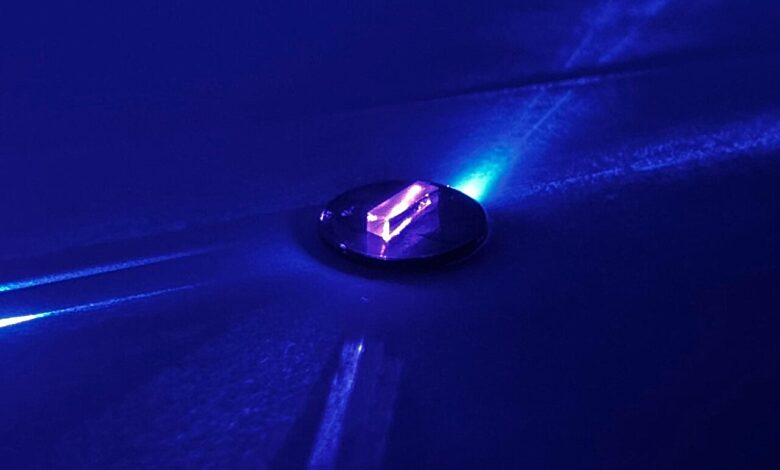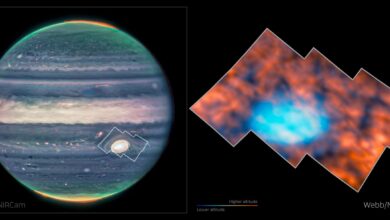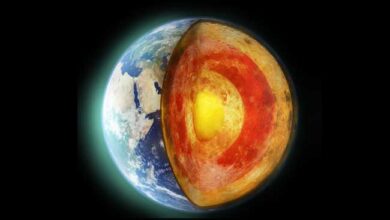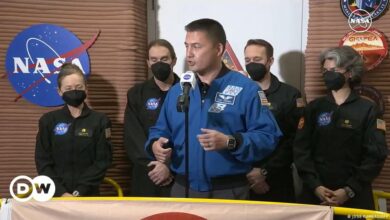Physicists’ laser experiment excites atom’s nucleus, may enable new type of atomic clock

[ad_1]

For nearly 50 years, physicists have dreamed of the secrets they could unlock by raising the energy state of an atom’s nucleus using a laser. The achievement would allow today’s atomic clocks to be replaced with a nuclear clock that would be the most accurate clock to ever exist, allowing advances like deep space navigation and communication. It would also allow scientists to measure precisely whether the fundamental constants of nature are, in fact, really constant or merely appear to be because we have not yet measured them precisely enough.
Now, an effort led by Eric Hudson, professor of physics and astronomy at UCLA, has accomplished the seemingly impossible. By embedding a thorium atom within a highly transparent crystal and bombarding it with lasers, Hudson’s group has succeeded in getting the nucleus of the thorium atom to absorb and emit photons like electrons in an atom do. The astonishing feat is described in a paper published in the journal Physical Review Letters.
This means that measurements of time, gravity and other fields that are currently performed using atomic electrons can be made with orders of magnitude higher accuracy. The reason is that atomic electrons are influenced by many factors in their environment, which affects how they absorb and emit photons and limits their accuracy. Neutrons and protons, on the other hand, are bound and highly concentrated within the nucleus and experience less environmental disturbance.
Using the new technology, scientists may be able to determine if fundamental constants, such as the fine-structure constant which sets the strength of the force that holds atoms together, vary. Hints from astronomy suggest that the fine-structure constant might not be the same everywhere in the universe or at all points in time. Precise measurement using the nuclear clock of the fine-structure constant could completely rewrite some of these most basic laws of nature.
“Nuclear forces are so strong it means the energy in the nucleus is a million times stronger than what you see in the electrons, which means that if the fundamental constants of nature deviate, the resulting changes in the nucleus are much bigger and more noticeable, making measurements orders of magnitude more sensitive,” Hudson said.
“Using a nuclear clock for these measurements will provide the most sensitive test of ‘constant variation’ to date and it is likely no experiment for the next 100 years will rival it.”
Hudson’s group was the first to propose a series of experiments to stimulate thorium-229 nuclei doped into crystals with a laser, and has spent the past 15 years working to achieve the newly published results. Getting neutrons in the atomic nucleus to react to laser light is challenging because they are surrounded by electrons, which react readily to light and can reduce the number of photons actually able to reach the nucleus. A particle that has raised its energy level, such as through absorption of a photon, is said to be in an “excited” state.
The UCLA team embedded thorium-229 atoms within a transparent crystal rich in fluorine. Fluorine can form especially strong bonds with other atoms, suspending the atoms and exposing the nucleus like a fly in a spider web. The electrons were so tightly bound with the fluorine that the amount of energy it would take to excite them was very high, allowing lower energy light to reach the nucleus. The thorium nuclei could then absorb these photons and re-emit them, allowing the excitation of the nuclei to be detected and measured.
By changing the energy of the photons and monitoring the rate at which the nuclei are excited, the team was able to measure the energy of the nuclear excited state.
“We have never been able to drive nuclear transitions like this with a laser before,” Hudson said. “If you hold the thorium in place with a transparent crystal, you can talk to it with light.”
Hudson said the new technology could find uses wherever extreme precision in timekeeping is required in sensing, communications and navigation. Existing atomic clocks based on electrons are room-sized contraptions with vacuum chambers to trap atoms and equipment associated with cooling. A thorium-based nuclear clock would be much smaller, more robust, more portable and more accurate.
“Nobody gets excited about clocks because we don’t like the idea of time being limited,” he said. “But we use atomic clocks all the time every day, for example, in the technologies that make our cell phones and GPS work.”
Above and beyond commercial applications, the new nuclear spectroscopy could pull back the curtains on some of the universe’s biggest mysteries. Sensitive measurement of an atom’s nucleus opens up a new way to learn about its properties and interactions with energy and the environment. This, in turn, will let scientists test some of their most fundamental ideas about matter, energy and the laws of space and time.
“Humans, like most life on Earth, exist at scales either far too small or far too large to observe what might really be going on in the universe,” Hudson said. “What we can observe from our limited perspective is a conglomeration of effects at different scales of size, time and energy and the constants of nature we’ve formulated seem to hold at this level.
“But if we could observe more precisely, these constants might actually vary. Our work has taken a big step toward these measurements and, either way, I am sure we will be surprised at what we learn.”
“For many decades, increasingly precise measurements of fundamental constants have allowed us to better understand the universe at all scales and subsequently develop new technologies that grow our economy and strengthen our national security,” said Denise Caldwell, acting assistant director of NSF’s Mathematical and Physical Sciences Directorate.
“This nucleus-based technique could one day allow scientists to measure some fundamental constants so precisely that we might have to stop calling them ‘constant.'”
More information:
R. Elwell et al, Laser Excitation of the Th229 Nuclear Isomeric Transition in a Solid-State Host, Physical Review Letters (2024). DOI: 10.1103/PhysRevLett.133.013201. On arXiv: DOI: 10.48550/arxiv.2404.12311
Provided by
University of California, Los Angeles
Citation:
Physicists’ laser experiment excites atom’s nucleus, may enable new type of atomic clock (2024, July 2)
retrieved 3 July 2024
from https://phys.org/news/2024-07-physicists-laser-atom-nucleus-enable.html
This document is subject to copyright. Apart from any fair dealing for the purpose of private study or research, no
part may be reproduced without the written permission. The content is provided for information purposes only.
[ad_2]
Source link




